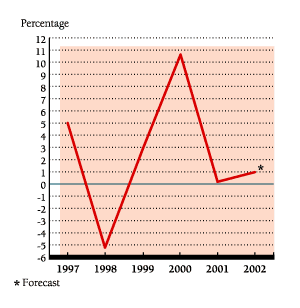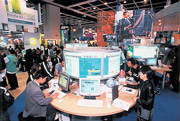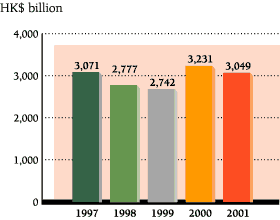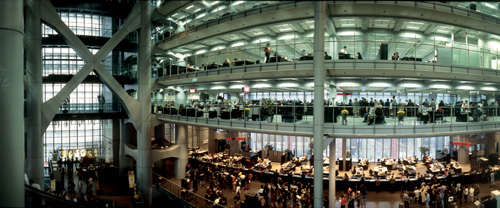- Upgrade market infrastructure by putting in place state-of-the-art
trading, clearing and settlement facilities capable of further integration
with the rest of the financial markets
- Modernise market structure by demutualising and merging the Exchanges
and their associated Clearing Houses and separating ownership from trading
rights. The securities and futures exchanges and clearing houses were
merged and listed on the Stock Exchange of Hong Kong in June 2000.
- Consolidate the 10 Ordinances governing the securities and futures
market and modernise the regulatory framework for maintaining a fair,
orderly and transparent market on par with international standards and
practices. The Securities and Futures Ordinance, passed by the Legislative
Council in March 2002, will help to further consolidate Hong Kong's
position as a major international financial centre and the premier capital
formation centre for the Mainland of China.
A NASDAQ-style second board, the Growth Enterprise Market (GEM) was launched in November 1999. The GEM provides a channel for emerging and growing companies, many in the technology field, to raise capital. At the end of April 2002, more than 125 companies with a market capitalisation of almost HK$70 billion (US$9 billion) were listed on the GEM.
In late 2000, a pilot programme was launched to allow the 'live trading' in the Asian time zone of seven leading NASDAQ stocks, six of which are technology or biotechnology counters.
A US Dollar real-time-gross-settlement (RTGS) payment system has been well received by the financial community since it was launched in August 2000. There are currently 64 direct and 125 indirect participants. Among the indirect participants, 84 are from overseas.
Turnover has grown steadily from 2 700 to 3 000 transactions worth over US$4 billion in 2001 to more than 3 000 transactions with a value of US$4.9 billion by January 2002. Payment Vs Payment transactions accounted for about one third of US Dollar RTGS turnover value in 2001.
Derivatives warrants were reintroduced into the market in January 2002 and quickly re-established demand, accounting for more than 5% of daily turnover.
To meet rising competition, a Task Force on Financial Market Development led by the Secretary for Financial Services was set up in 2002 to explore ways to increase market liquidity by encouraging new players and developing new products and services.
Mandatory Provident Fund System
The Mandatory Provident Fund (MPF) System was introduced in December 2000 to help Hong Kong workers save financially for their futures.
This privately-managed, compulsory retirement protection scheme has added greater depth to Hong Kong's financial services sector and has had a positive affect on the long-term development of the bond and securities markets.
Under the system, all employees aged between 18 and 65 (unless exempt) contribute 5% of their monthly wage, up to a maximum of HK$1,000 (US$128). Their contribution is matched by the employer. Self-employed people also contribute 5% of their income to the scheme, subject to the same maximum.
At the end of its first year of operation, accrued assets of MPF schemes had surged to HK$36 billion (US$4.6 billion). By the end of April 2002, 92% of employers, 96% of relevant employees and 85% of self-employed persons had enrolled in MPF schemes.
MPF schemes are expected to inject up to HK$60 billion (US$7.7 billion) annually into the fund management market by 2030.
 |
The Asian financial crisis buffeted Hong Kong from late 1997 until the end of 1999. A robust but short-lived recovery in 2000 gave way to insignificant growth in 2001 on the back of the global economic slowdown.
Per capita GDP stood at HK$187,700 (US$24,100) in 2001, but is still considerably lower than the 1997 levels of HK$204,007 (US$26,400).
Since 1997, annual trade flows have averaged HK$2,974 billion, about 3% lower than 1997 total trade of HK$3,071 billion. The year-on-year value of total trade dropped in 1998 and 1999 before rebounding sharply in 2000 and dropping again in 2001. Total trade by value dropped by HK$56 billion, or 8% year-on-year, in the first quarter of 2002.
Since late 1997, Hong Kong's economy has been grappling with a painful restructuring that has seen asset prices drop considerably and unemployment rise to a record level of over 7%.
 |
The bursting of a property and stock market bubble in late 1997 and early 1998 has had a major and prolonged impact on consumer sentiment. Prices (measured by the Composite Consumer Price Index) have dropped for more than three years and are forecast to drop a further 2.8% for 2002 as a whole. This is due, in part, to the combined effects of government relief measures to help lower costs in the economy.
Total Trade 1997-2001
 |
In general, lower housing and office rentals have helped boost Hong Kong's competitiveness. Housing prices have dropped by more than 50% off their mid-1997 peaks, while rentals have eased 30%.
Hong Kong's currency, linked since 1983 to the US Dollar at a rate of HK$7.80 = US$1, has remained rock solid over the past five years. In line with US interest rates, local interest rates came down considerably during 2001.
In August 1998, the currency came under speculative attack by some aggressive market players. The government took the unprecedented step of launching a defensive incursion into the stock and futures markets to restore a level playing field.
During a one-month operation, the government spent a total of HK$118 billion (US$15 billion) buying the 33 constituent stocks of the Hang Seng Index. The stocks bought during that exercise have gradually been put back onto the market in an orderly manner through a Tracker Fund, launched in November 1999, that tracks the movement of the Hang Seng Index.
The financial sector has undergone major reform and enhancement over the past five years to boost the attractiveness of Hong Kong as an international financial centre.
Following the 1998 speculative attacks on the currency, the Hong Kong Monetary Authority boosted the transparency of the Currency Board System to help prevent further manipulation and to provide a more complete picture of the strengths of the reserves underpinning Hong Kong's currency.

Reforms were also introduced to further enhance competitiveness, efficiency and innovation in the banking sector which led to the elimination of all interest rates rules.
To strengthen Hong Kong's competitiveness as an international financial centre, the Financial Secretary in 1999 announced a three-pronged reform of the securities and futures market.
Key elements of the reforms have been to: